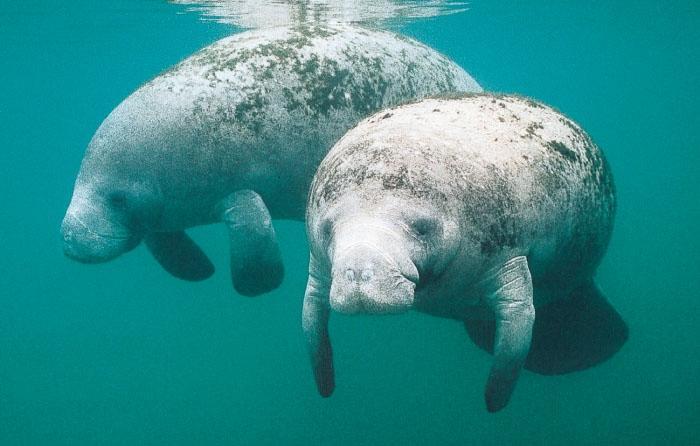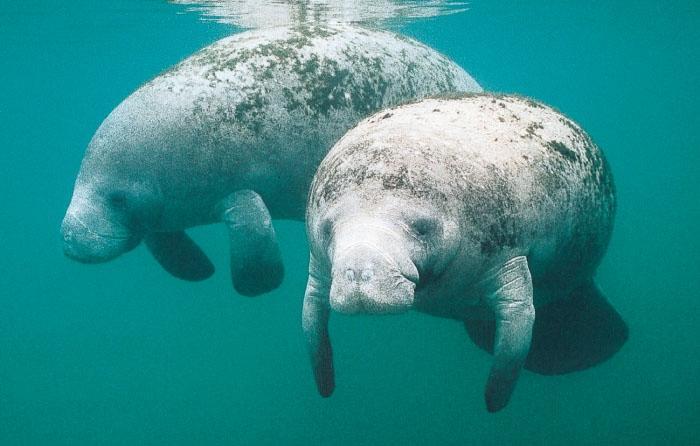
Credit: Photo: USGS
Florida's iconic manatee population is highly likely to endure for the next 100 years, so long as wildlife managers continue to protect the marine mammals and their habitat, a new study by the US Geological Survey and the Florida Fish and Wildlife Research Institute has found.
The study, conducted by a team of veteran manatee scientists, estimated there is less than a one-half of one percent chance that either Florida's Atlantic or its Gulf of Mexico manatee population could fall to as few as 500 adults – the level that could imperil Florida manatees' long-term survival.
"Today the Florida manatees' numbers are high. Adult manatees' longevity is good, and the state has available habitat to support a population that is continuing to grow," said USGS research ecologist Michael C. Runge, lead author of the USGS report, "Status and Threats Analysis for the Florida Manatee (Trichechus manatus latirostris), 2016," published today.
"Still, new threats could emerge, or existing threats could interact in unexpected ways," Runge said. "Managers need to remain vigilant to keep manatee populations viable over the long haul."
Florida's manatee population is likely to gradually double over the next 50 years and then level off, the research team concluded. Over time, environmental and habitat changes will probably cause manatees to become less abundant in South Florida and more numerous in North Florida, but the population as a whole will remain high.
The Florida manatee is a subspecies of the West Indian manatee, one of the first creatures listed as endangered when the federal Endangered Species Act went into effect in 1973. In the mid-1970s only about 1,000 individuals survived in Florida. But over the last 40 years, boat speed regulations, habitat protection and other measures have helped the population rebound. The most recent count, in early 2017, tallied 6,620 manatees in Florida waters.
On March 30, 2017 the U.S. Fish and Wildlife Service, which is charged with protecting plants and animals covered by the Endangered Species Act, announced a final decision changing the West Indian manatee's status (including the Florida subspecies) from endangered – the law's gravest classification – to threatened. Information from the USGS' new threat assessment was used by the USFWS in making its decision.
Scientists of the Sirenia Project, based at the USGS' Wetland and Aquatic Research Center in Gainesville, Florida, have studied manatees since the 1970s, photographing more than 3,000 animals and identifying them from each individual's unique pattern of propeller scars and other markings. From a database of more than 750,000 manatee photographs, satellite tracking, genetic information and other data, the USGS researchers and their FWRI partners have developed a detailed understanding of how manatees interact with their environment.
At USGS' Patuxent Wildlife Research Center in Laurel, Maryland, endangered species experts feed this information into a computer model that assesses how Florida manatee populations are doing and how they're likely to fare in coming decades. The model is updated periodically, incorporating insights from experts and new information about changing conditions.
"The long-term collaboration between USGS and FWRI has been integral to the development of the population model," said USGS research wildlife biologist and report co-author Catherine Langtimm. "Our joint efforts on the model began in the early 2000s, but the collaborative field studies extend back to the 1980s. Blending state and federal research capabilities and expertise has been critical in monitoring and studying Florida's manatee populations."
The study published today is the latest overview.
It shows that in the coming decades, manatee populations will continue to face two longstanding, serious threats: fatal collisions with watercraft, and the loss of warm-water habitats that provide them with refuge during the winter. (Manatees lack an insulating layer of fat, so water colder than about 70 degrees can kill them.) The new analysis projects that mortality due to red tide will become an equally significant threat, if red tides are more frequent and more intense in coming decades.
The researchers tested many scenarios, some likely and some unlikely, to see whether they could find a set of circumstances that would trigger a significant statewide decline in the manatee population.
"If the rate of mortality from watercraft collisions were to double, the population's resilience would be compromised," said Runge. In that scenario, the risk that either the Atlantic or Gulf populations could fall to 500 animals was about four percent, he said. "We looked at all the other pressures people have mentioned, and we did not find any combination of threats that raised the risk of a decline to fewer than 500 animals on either coast above nine percent."
The next 100 years are likely to see manatee populations shift around the state in response to regional environmental changes, the analysis finds. For example, some southeast Florida power plants are expected to shut down over the next 40-50 years, and if they do, manatees will lose the warm water refuges created in the plants' discharge canals. Manatees in southwest Florida are likely to be increasingly affected by red tide and may also lose some warm water refuges. So southeast and southwest Florida may see their manatee populations decline.
Those losses will be balanced by increased manatee numbers in northeast and northwest Florida, where warm natural springs are capable of hosting more manatees, the analysis concludes.
"Manatee populations will continue to face threats," Runge said. "But if these threats continue to be managed effectively, manatees will be an integral and iconic part of Florida's coastal ecosystems through the coming century."
###
For more information about USGS scientists' recent research on manatees, visit https://www.usgs.gov/center-news/media-inquiries-usgs-manatee-research?qt-news_science_products=0#qt-news_science_products.
Media Contact
Heather Dewar
[email protected]
352-264-3542
@USGS
http://www.usgs.gov
############
Story Source: Materials provided by Scienmag





